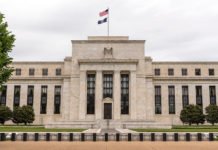With the downside risks to growth now believed to be as significant as inflation’s potential upside, the FOMC are beginning to look beyond the tightening cycle.
At their July meeting, the FOMC decided to raise the fed funds rate by 25bps as expected to a mid-point of 5.375%. Also in line with prior communications and the market’s expectations was the detail and tone of the statement and press conference. The focus throughout was the robust health of the economy today, but also the scale of the tightening delivered and the lags with which policy impacts.
Looking first at the guidance for activity, the assessment of GDP growth in the decision statement was strengthened (“modest” replaced by “moderate”). Job gains also continued to be characterised as robust; and, in the press conference, Chair Powell made clear the FOMC still view labour demand as greater than available supply, albeit less so than earlier in the cycle. In terms of the risks, there was no evidence of concern over the outlook for activity or the labour market; however, it is clear that the full weight of policy is yet to impact, and Chair Powell also emphasised that the latest evidence on credit conditions (from the upcoming Senior Loan Officer Survey) point to already tight conditions tightening further.
On prices, Chair Powell sought to carefully balance the still “elevated” level of inflation with the material progress seen of late. Clearly one better-than-expected print on inflation should not be taken as an ‘all clear’ signal and momentum in the highly-weighted shelter component is still extraordinary and set to slow only at a moderate pace; but we have now seen annual core goods inflation abate below the 2.0%yr headline target, from a peak above 12%yr, and core services ex-shelter or ‘supercore’ inflation retreat 2.5ppts from a peak of 6.5%yr to 4.0%yr, having averaged 1.4% annualised through Q2. As we continue to highlight, US inflation ex-shelter is now benign and the full effect of rate hikes yet to be felt.
For policy, broadly speaking, the downside risks to activity are now believed to be as significant as upside uncertainty for inflation. Decisions in coming months are therefore set to be determined by incoming data, specifically how it confirms/ conflicts with that already received. Less clear, but also highly significant, is the state of financial conditions which need to remain restrictive at least through the end of 2023. Note, this does not mean the FOMC want to keep term interest rates at their current absolute level; instead, they desire for the decline in term interest rates to lag the deceleration in inflation, keeping real interest rates materially above zero.
Worth reflecting on for early-2024 are Chair Powell’s comments late in the press conference regarding the timing of fed fund rate decisions vis a vis the 2.0%yr target. In short, he made clear that policy lags have to factored in, and hence that the Committee must stop hiking and start cutting before inflation reaches 2.0%yr. This perspective is entirely consistent with our expectation of a first cut in March 2024, with the annualised pace of inflation by that time likely 2.0%, but the annual rate still somewhat above (on our forecasts).
Also of note from the press conference is that Chair Powell believes a return to neutral, or potentially an expansionary policy setting, will be appropriate once inflation risks have abated. This points towards a large reduction in the fed funds rate to around 2.50% (the FOMC’s ‘longer run’ expectation) in contrast to the current 3.4% end-2025 median expectation of the Committee. Having peaked at its current level of 5.375%, Westpac sees the fed funds rate down at 2.625% mid-2025 and the US 10 year yield stabilising around 2.70%.
On the information to hand, the risk that the fed funds rate is increased further in the near term and/or the forecast decline in rates to mid-2025 proves much shallower than we currently forecast is set to be determined by capacity constraints across the US economy, particularly housing. Also critical will be how inflation expectations are affected. On the latter, the degree to which nominal wage growth exceeds inflation over the period will define the risk to broader inflation and its persistence.













